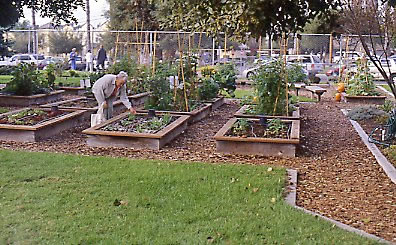| GARDEN DESIGN | |
|
•
|
Introduction | |
| • | Size | |
| • | A Garden for all Seasons | |
| • | Pathways and Common Spaces | • |
| • | Planting Beds | |
| • | Sun Exposure | |
| • | Watering Systems | |
| • | Tables and Seating for Children and Adults | |
| • | Work Benches for Potting Projects | |
| • | Compost Areas | |
| • | Storage | |
| • | Related Presentation |
|
Pathways and Common Spaces School gardens typically will have large numbers of students working for short periods of time. Paths must be wide enough to accommodate the largest class and sometimes multiple classes at one time. The size of pathways can also be determined by the width of the largest piece of equipment to be used in the garden. Locate paths on all sides of beds to provide easy access and reduce stepping into planting beds.
The surface on pathways may be native soil compacted to a hard density for ease of maintenance. Plain dirt has the advantage of easy weed removal. However, weeds sprout more abundantly and the paths become muddy during hand watering and rainy weather. Tree bark or chips are inexpensive additives to control weeds and mud, but must be replaced periodically. Permanent paths of brick, stone or concrete provide an effective weed and mud control and add to garden décor, but are the most expensive alternative. Click here to link to Design Accessibility for Physically Challenged Children and Adults for information on pathways for the physically challenged. |
